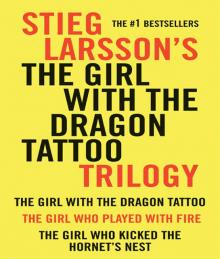- Home
- Stieg Larsson
Millennium 03 - The Girl Who Kicked the Hornet's Nest Page 20
Millennium 03 - The Girl Who Kicked the Hornet's Nest Read online
Page 20
After Cortez left, Blomkvist got out his anonymous mobile and called Daniel Olsson, a freelance journalist in Göteborg. Over the years Millennium had published several of his articles and Blomkvist had great faith in his ability to gather background material.
“Hi, Daniel. Mikael Blomkvist here. Can you talk?”
“Sure.”
“I need someone for a research job. You can bill us for five days, and you don’t have to produce an article at the end of it. Well, you can write an article on the subject if you want and we’ll publish it, but it’s the research we’re after.”
“Fine. Tell me.”
“It’s sensitive. You can’t discuss this with anyone except me, and you can communicate with me only via hotmail. You must not even mention that you’re doing research for Millennium.”
“This sounds fun. What are you looking for?”
“I want you to do a workplace report on Sahlgrenska hospital. We’re calling the report ‘E.R.’, and it’s to look at the differences between reality and the T. V. series. I want you to go to the hospital and observe the work in the emergency ward and the intensive care unit for a couple of days. Talk with doctors, nurses and cleaners – everybody who works there in fact. What are their working conditions like? What do they actually do? That sort of stuff. Photographs too, of course.”
“Intensive care?” Olsson said.
“Exactly. I want you to focus on the follow-up care given to severely injured patients in corridor 11C. I want to know the whole layout of the corridor, who works there, what they look like, and what sort of background they have.”
“Unless I’m mistaken, a certain Lisbeth Salander is a patient on 11C.”
Olsson was not born yesterday.
“How interesting,” Blomkvist said. “Find out which room she’s in, who’s in the neighbouring rooms, and what the routines are in that section.”
“I have a feeling that this story is going to be about something altogether different,” Olsson said.
“As I said … all I want is the research you come up with.”
They exchanged hotmail addresses.
Salander was lying on her back on the floor when Nurse Marianne came in.
“Hmm,” she said, thereby indicating her doubts about the wisdom of this style of conduct in the intensive care unit. But it was, she accepted, her patient’s only exercise space.
Salander was sweating. She had spent thirty minutes trying to do arm lifts, stretches and sit-ups on the recommendation of her physiotherapist. She had a long list of the movements she was to perform each day to strengthen the muscles in her shoulder and hip in the wake of her operation three weeks earlier. She was breathing hard and felt wretchedly out of shape. She tired easily and her left shoulder was tight and hurt at the very least effort. But she was on the path to recovery. The headaches that had tormented her after surgery had subsided and came back only sporadically.
She realized that she was sufficiently recovered now that she could have walked out of the hospital, or at any rate hobbled out, if that had been possible, but it was not. First of all, the doctors had not yet declared her fit, and second, the door to her room was always locked and guarded by a fucking hit-man from Securitas, who sat on his chair in the corridor.
She was healthy enough to be moved to a normal rehabilitation ward, but after going back and forth about this, the police and hospital administration had agreed that Salander should remain in room eighteen for the time being. The room was easier to guard, there was round-the-clock staff close by, and the room was at the end of an L-shaped corridor. And in corridor 11C the staff were security-conscious after the killing of Zalachenko; they were familiar with her situation. Better not to move her to a new ward with new routines.
Her stay at Sahlgrenska was in any case going to come to an end in a few more weeks. As soon as the doctors discharged her, she would be transferred to Kronoberg prison in Stockholm to await trial. And the person who would decide when it was time for that was Dr Jonasson.
It was ten days after the shooting in Gosseberga before Dr Jonasson gave permission for the police to conduct their first real interview, which Giannini viewed as being to Salander’s advantage. Unfortunately Dr Jonasson had made it difficult even for Giannini to have access to her client, and that was annoying.
After the tumult of Zalachenko’s murder and Gullberg’s attempted suicide, he had done an evaluation of Salander’s condition. He took into account that Salander must be under a great deal of stress for having been suspected of three murders plus a damn-near fatal assault on her late father. Jonasson had no idea whether she was guilty or innocent, and as a doctor he was not the least bit interested in the answer to that question. He simply concluded that Salander was suffering from stress, that she had been shot three times, and that one bullet had entered her brain and almost killed her. She had a fever that would not abate, and she had severe headaches.
He had played it safe. Murder suspect or not, she was his patient, and his job was to make sure she got well. So he filled out a “no visitors” form that had no connection whatsoever to the one that was set in place by the prosecutor. He prescribed various medications and complete bedrest.
But Jonasson also realized that isolation was an inhumane way of punishing people; in fact it bordered on torture. No-one felt good when they were separated from all their friends, so he decided that Salander’s lawyer should serve as a proxy friend. He had a serious talk with Giannini and explained that she could have access to Salander for one hour a day. During this hour she could talk with her or just sit quietly and keep her company, but their conversations should not deal with Salander’s problems or impending legal battles.
“Lisbeth Salander was shot in the head and was very seriously injured,” he explained. “I think she’s out of danger, but there is always a risk of bleeding or some other complication. She needs to rest and she has to have time to heal. Only when that has happened can she begin to confront her legal problems.”
Giannini understood Dr Jonasson’s reasoning. She had some general conversations with Salander and hinted at the outline of the strategy that she and Blomkvist had planned, but Salander was simply so drugged and exhausted that she would fall asleep while Giannini was speaking.
Armansky studied Malm’s photographs of the men who had followed Blomkvist from the Copacabana. They were in sharp focus.
“No,” he said. “Never seen them before.”
Blomkvist nodded. They were in Armansky’s office on Monday morning. Blomkvist had come into the building via the garage.
“The older one is Göran Mårtensson, who owns the Volvo. He followed me like a guilty conscience for at least a week, but it could have been longer.”
“And you reckon that he’s Säpo.”
Blomkvist referred to Mårtensson’s C.V. Armansky hesitated.
You could take it for granted that the Security Police invariably made fools of themselves. That was the natural order of things, not for Säpo alone but probably for intelligence services all over the world. The French secret police had sent frogmen to New Zealand to blow up the Greenpeace ship Rainbow Warrior, for God’s sake. That had to be the most idiotic intelligence operation in the history of the world. With the possible exception of President Nixon’s lunatic break-in at Watergate. With such cretinous leadership it was no wonder that scandals occurred. Their successes were never reported. But the media jumped all over the Security Police whenever anything improper or foolish came to light, and with all the wisdom of hindsight.
On the one hand, the media regarded Säpo as an excellent news source, and almost any political blunder gave rise to headlines: “Säpo suspects that …” A Säpo statement carried a lot of weight in a headline.
On the other hand, politicians of various affiliations, along with the media, were particularly diligent in condemning exposed Säpo agents if they had spied on Swedish citizens. Armansky found this entirely contradictory. He did not have anything against the existence
of Säpo. Someone had to take responsibility for seeing to it that national-Bolshevist crackpots – who had read too much Bakunin or whoever the hell these neo-Nazis read – did not patch together a bomb made of fertilizer and oil and park it in a van outside Rosenbad. Säpo was necessary, and Armansky did not think a little discreet surveillance was such a bad thing, so long as its objective was to safeguard the security of the nation.
The problem, of course, was that an organization assigned to spy on citizens must remain under strict public scrutiny. There had to be a high level of constitutional oversight. But it was almost impossible for Members of Parliament to have oversight of Säpo, even when the Prime Minister appointed a special investigator who, on paper at least, was supposed to have access to everything. Armansky had Blomkvist’s copy of Lidbom’s book An Assignment, and he was reading it with gathering astonishment. If this were the United States a dozen or so senior Säpo hands would have been arrested for obstruction of justice and forced to appear before a public committee in Congress. In Sweden apparently they were untouchable.
The Salander case demonstrated that something was out of joint inside the organization. But when Blomkvist came over to give him a secure mobile, Armansky’s first thought was that the man was paranoid. It was only when he heard the details and studied Malm’s photographs that he reluctantly admitted that Blomkvist had good reason to be suspicious. It did not bode well, but rather indicated that the conspiracy that had tried to eliminate Salander fifteen years earlier was not a thing of the past.
There were simply too many incidents for this to be coincidence. Never mind that Zalachenko had supposedly been murdered by a nutter. It had happened at the same time that both Blomkvist and Giannini were robbed of the document that was the cornerstone in the burden of proof. That was a shattering misfortune. And then the key witness, Gunnar Björck, had gone and hanged himself.
“Are we agreed that I pass this on to my contact?” Armansky said, gathering up Blomkvist’s documentation.
“And this is a person that you say you can trust?”
“An individual of the highest moral standing.”
“Inside Säpo?” Blomkvist said with undisguised scepticism.
“We have to be of one mind. Both Holger and I have accepted your plan and are co-operating with you. But we can’t clear this matter up all by ourselves. We have to find allies within the bureaucracy if this is not going to end in calamity.”
“O.K.” Blomkvist nodded reluctantly. “I’ve never had to give out information on a story before it’s published.”
“But in this case you already have. You’ve told me, your sister, and Holger.”
“True enough.”
“And you did it because even you recognize that this is far more than just a scoop in your magazine. For once you’re not an objective reporter, but a participant in unfolding events. And as such you need help. You’re not going to win on your own.”
Blomkvist gave in. He had not, in any case, told the whole truth either to Armansky or to his sister. He still had one or two secrets that he shared only with Salander.
He shook hands with Armansky.
CHAPTER 9
Wednesday, 4.v
Three days after Berger started as acting editor-in-chief of S.M.P., Editor-in-Chief Morander died at lunchtime. He had been in the glass cage all morning, while Berger and assistant editor Peter Fredriksson met the sports editors so that she could get to know her colleagues and find out how they worked. Fredriksson was forty-five years old and also relatively new to the paper. He was taciturn but pleasant, with a broad experience. Berger had already decided that she would be able to depend on Fredriksson’s insights when she took command of the ship. She was spending a good part of her time evaluating the people she might be able to count on and could then make part of her new regime. Fredriksson was definitely a candidate.
When they got back to the news desk they saw Morander get up and come over to the door of the glass cage. He looked startled.
Then he leaned forward, grabbed the back of a chair and held on to it for a few seconds before he collapsed to the floor.
He was dead before the ambulance arrived.
There was a confused atmosphere in the newsroom throughout the afternoon. Chairman of the Board Borgsjö arrived at 2.00 and gathered the employees for a brief memorial to Morander. He spoke of how Morander had dedicated the past fifteen years of his life to the newspaper, and the price that the work of a newspaperman can sometimes exact. Finally he called for a minute’s silence.
Berger realized that several of her new colleagues were looking at her. The unknown quantity.
She cleared her throat and without being invited to, without knowing what she would say, took half a step forward and spoke in a firm voice: “I knew Håkan Morander for all of three days. That’s too short a time, but from even the little I managed to know of him, I can honestly say that I would have wanted very much to know him better.”
She paused when she saw out of the corner of her eye that Borgsjö was staring at her. He seemed surprised that she was saying anything at all. She took another pace forward.
“Your editor-in-chief’s untimely departure will create problems in the newsroom. I was supposed to take over from him in two months, and I was counting on having the time to learn from his experience.”
She saw that Borgsjö had opened his mouth as if to say something himself.
“That won’t happen now, and we’re going to go through a period of adjustment. But Morander was editor-in-chief of a daily newspaper, and this paper will come out tomorrow too. There are now nine hours left before we go to press and four before the front page has to be resolved. May I ask … who among you was Morander’s closest confidant?”
A brief silence followed as the staff looked at each other. Finally Berger heard a voice from the left side of the room.
“That would probably be me.”
It was Gunnar Magnusson, assistant editor of the front page who had worked on the paper for thirty-five years.
“Somebody has to write an obit. I can’t do it … that would be presumptuous of me. Could you possibly write it?”
Magnusson hesitated a moment but then said, “I’ll do it.”
“We’ll use the whole front page and move everything else back.”
Magnusson nodded.
“We need images.” She glanced to her right and met the eye of the pictures editor, Lennart Torkelsson. He nodded.
“We have to get busy on this. Things might be a bit rocky at first. When I need help making a decision, I’ll ask your advice and I’ll depend on your skill and experience. You know how the paper is made and I have a while to go on the school bench.”
She turned to Fredriksson.
“Peter, Morander put a great deal of trust in you. You will have to be something of a mentor to me for the time being, and carry a heavier load than usual. I’m asking you to be my adviser.”
He nodded. What else could he do?
She returned to the subject of the front page.
“One more thing. Morander was writing his editorial this morning. Gunnar, could you get into his computer and see whether he finished it? Even if it’s not quite rounded out, we’ll publish it. It was his last editorial and it would be a crying shame not to print it. The paper we’re making today is still Håkan Morander’s paper.”
Silence.
“If any of you need a little personal time, or want to take a break to think for a while, do it, please. You all know our deadlines.”
Silence. She noticed that some people were nodding their approval.
“Go to work, boys and girls,” she said in English in a low voice.
Holmberg threw up his hands in a helpless gesture. Bublanski and Modig looked dubious. Andersson’s expression was neutral. They were scrutinizing the results of the preliminary investigation that Holmberg had completed that morning.
“Nothing?” Modig said. She sounded surprised.
“Nothing
,” Holmberg said, shaking his head. “The pathologist’s final report arrived this morning. Nothing to indicate anything but suicide by hanging.”
They looked once more at the photographs taken in the living room of the summer cabin in Smådalarö. Everything pointed to the conclusion that Gunnar Björck, assistant chief of the Immigration Division of the Security Police, had climbed on to a stool, tied a rope to the lamp hook, placed it around his neck, and then with great resolve kicked the stool across the room. The pathologist was unable to supply the exact time of death, but he had established that it occurred on the afternoon of April 12. The body had been discovered on April 19 by none other than Inspector Andersson. This happened because Bublanski had repeatedly tried to get hold of Björck. Annoyed, he finally sent Andersson to bring him in.
Sometime during that week, the lamp hook in the ceiling came away and Björck’s body fell to the floor. Andersson had seen the body through a window and called in the alarm. Bublanski and the others who arrived at the summer house had treated it as a crime scene from the word go, taking it for granted that Björck had been garrotted by someone. Later that day the forensic team found the lamp hook. Holmberg had been tasked to work out how Björck had died.
“There’s nothing whatsoever to suggest a crime, or that Björck was not alone at the time,” Holmberg said.
“The lamp?”
“The ceiling lamp has fingerprints from the owner of the cabin – who put it up two years ago – and Björck himself. Which says that he took the lamp down.”
“Where did the rope come from?”
“From the flagpole in the garden. Someone cut off about two metres of rope. There was a Mora sheath knife on the windowsill outside the back door. According to the owner of the house, it’s his knife. He normally keeps in a tool drawer underneath the draining board. Björck’s prints were on the handle and the blade, as well as the tool drawer.”
“Hmm,” Modig said.
“What sort of knots?” Andersson said.
“Granny knots. Even the noose was just a loop. It’s probably the only thing that’s a bit odd. Björck was a sailor, he would have known how to tie proper knots. But who knows how much attention a person contemplating suicide would pay to the knots on his own noose?”

 The Girl with the Dragon Tattoo
The Girl with the Dragon Tattoo The Girl Who Kicked the Hornet's Nest
The Girl Who Kicked the Hornet's Nest The Girl Who Played with Fire
The Girl Who Played with Fire The Girl with the Dragon Tattoo m(-1
The Girl with the Dragon Tattoo m(-1 The Girl who played with Fire m(-2
The Girl who played with Fire m(-2 Millennium 01 - The Girl with the Dragon Tattoo
Millennium 01 - The Girl with the Dragon Tattoo The Girl Who Kicked The Hornets’ Nest m(-3
The Girl Who Kicked The Hornets’ Nest m(-3 Millennium 02 - The Girl Who Played with Fire
Millennium 02 - The Girl Who Played with Fire Millennium 03 - The Girl Who Kicked the Hornet's Nest
Millennium 03 - The Girl Who Kicked the Hornet's Nest The Girl With the Dragon Tattoo Trilogy Bundle
The Girl With the Dragon Tattoo Trilogy Bundle![Millenium [02] The Girl Who Played With Fire Read online](http://i1.bookreadfree.com/i2/04/12/millenium_02_the_girl_who_played_with_fire_preview.jpg) Millenium [02] The Girl Who Played With Fire
Millenium [02] The Girl Who Played With Fire